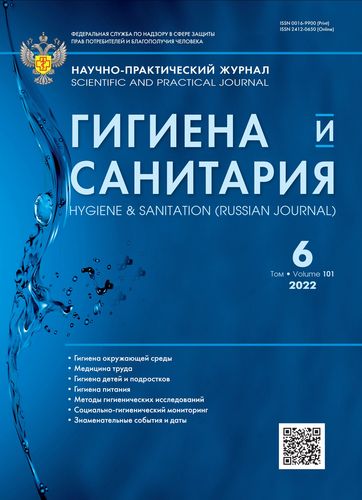Regional peculiarities of the epidemiological process caused by SARS-COV-2 (COVID-19), compensation for the impact of modifying factors of non-infectious genesis
- Authors: Zaitseva N.V.1, Popova A.Y.2, Alekseev V.B.1, Kiryanov D.A.1, Chigvintsev V.M.1
-
Affiliations:
- Federal Scientific Center for Medical and Preventive Health Risk Management Technologies
- Russian Medical Academy for Continuous Occupational Education
- Issue: Vol 101, No 6 (2022)
- Pages: 701-708
- Section: SOCIO-HYGIENIC MONITORING
- Published: 30.06.2022
- URL: https://archivog.com/0016-9900/article/view/639168
- DOI: https://doi.org/10.47470/0016-9900-2022-101-6-701-708
- ID: 639168
Cite item
Full Text
Abstract
Introduction. The development of SARS-COV-2 (COVID-19) pandemic creates certain analytical challenges with respect to both examining the spread of the disease itself and investigating reasons and regularities in the epidemic propagation under different conditions. This article dwells on the least examined issue related to the necessity to establish peculiarities and reasons for occurring differences in the coronavirus infection spread in RF regions with different socioeconomic and social-hygienic status. This is necessary for substantiating relevant actions, which are to compensate for preventable modifying influence exerted by environmental factors and lifestyle-related ones.
Materials and methods. The study involved analyzing regularities in regional differentiation of parameters in a classic SIR model describing the epidemic process in RF regions. We analyzed data on more than two hundred fifty various indicators describing levels of infection, vaccination, hospital admission and mortality among population collected in 85 RF regions in 2020–2021. All the data were taken as average values over a week.
Results. We assessed parameters of mathematical models for RF regions. The assessments gave grounds for analyzing peculiar development of the epidemic process and for detecting basic regularities in the territorial distribution of parameters describing rates of infection, recovery and mortality rate and the basic reproductive number for SARS-COV-2 virus.
Limitations. The results are limited by data aggregation performed only at a regional level and a simplified model of the developing epidemic process applied in the present study. Another limitation is insufficient coverage of environmental factors reflecting peculiarities in the infection spread. The latter is considered a promising trend in future research.
Conclusion. The study made it possible to trace basic peculiarities and regularities in the spread of the disease and to spot out regions where the epidemic process was the most acute and accompanied with the highest burdens on regional social security services. These trends and regularities indicate to the occurring regional differentiation detected at various stages in the development of epidemic process of the new coronavirus infection (COVID-19) spread due to the Delta strain caused by complex interactions and influence exerted by modifying factors creating a certain multi-level and multi-component structure.
Compliance with ethical standards. The study was approved by the local ethical committee of the Federal Scientific Center for Medical and Preventive Health Risk Management Technologies.
Contribution:
Zaitseva N.V. — the study concept and design, writing, editing;
Popova А.Yu. — the study concept and design, writing, editing;
Alekseev V.B. — the study concept and design, writing;
Kiryanov D.А. — the study concept and design, data collection and analysis, writing;
Chigvintsev V.М. — data collection and analysis, writing.
All authors are responsible for the integrity of all parts of the manuscript and approval of the manuscript final version.
Conflict of interest. The authors declare no conflict of interest.
Acknowledgement. The study had no sponsorship.
Received: April 11, 2022 / Accepted: June 8, 2022 / Published: June 26, 2022
Keywords
About the authors
Nina V. Zaitseva
Federal Scientific Center for Medical and Preventive Health Risk Management Technologies
Author for correspondence.
Email: noemail@neicon.ru
ORCID iD: 0000-0003-2356-1145
Russian Federation
Anna Yu. Popova
Russian Medical Academy for Continuous Occupational Education
Email: noemail@neicon.ru
ORCID iD: 0000-0003-2567-9032
Russian Federation
Vadim B. Alekseev
Federal Scientific Center for Medical and Preventive Health Risk Management Technologies
Email: noemail@neicon.ru
ORCID iD: 0000-0001-5850-7232
Russian Federation
Dmitriy A. Kiryanov
Federal Scientific Center for Medical and Preventive Health Risk Management Technologies
Email: noemail@neicon.ru
ORCID iD: 0000-0002-5406-4961
Russian Federation
Vladimir M. Chigvintsev
Federal Scientific Center for Medical and Preventive Health Risk Management Technologies
Email: cvm@fcrisk.ru
ORCID iD: 0000-0002-0345-3895
MD, researcher at the Department for Mathematical Modeling of Systems and Processes, the Federal Scientific Center for Medical and Preventive Health Risk Management Technologies, Perm 614045, Russian Federation.
e-mail: cvm@fcrisk.ru
Russian FederationReferences
- Krivorotko O.I., Kabanikhin S.I. Mathematical models of the COVID-19 spread. arXiv. Preprint. 2021; arXiv:2112.05315. https://doi.org/10.48550/arXiv.2112.05315
- Efimova T.A., Timoshchenko I.A., Abrashina-Zhadaeva N.G. Fractional differential model of the spread of COVID-19. Journal of the Belarusian State University. Physics. 2021; 3: 40–8.
- Tarutin A. Modeling of virus epidemics. Innovatsii. Nauka. Obrazovanie. 2021; (27): 930–8. (in Russian)
- Yanchevskaya E.Yu., Mesnyankina O.A. Mathematical modelling and prediction in infectious disease epidemiology. Vestnik Rossiyskogo universiteta druzhby narodov. Seriya: Meditsina. 2019; 23(3): 328–34. https://doi.org/10.22363/2313-0245-2019-23-3-328-334 (in Russian)
- Akimov V.A., Didenko S.L., Oltyan I.Yu. Biological and social emergencies modeling using the SIR epidemiological model. Tekhnologii grazhdanskoy bezopasnosti. 2020; (4): 4–8. (in Russian)
- Kontarov N.A., Arkharova G.V., Grishunina Yu.B., Grishunina S.A., Yuminova N.V. SIR+a mathematical model for evaluating and predicting 2016–2017 ARVI-influenza incidence by using on the Moscow territory. Infektsiya i immunitet. 2019; 9(3–4): 583–8. https://doi.org/10.15789/2220-7619-2019-3-4-583-588 (in Russian)
- Razumov T.E. SIR epidemic model taking into account the spatial heterogeneity of the location of individuals. Politekhnicheskiy molodezhnyy zhurnal. 2019; (6): 5. https://doi.org/10.18698/2541-8009-2019-6-490 (in Russian)
- Sokolovskiy V.L., Furman G.B., Polyanskaya D.A., Furman E.G. Spatio-temporal modeling of Covid-19 epidemic. Analiz riska zdorov’yu. 2021; (1): 23–37. https://doi.org/10.21668/health.risk/2021.1.03 (in Russian)
- Dos Santos I.F.F., Almeida G.M.A., de Moura F.A.B.F. Adaptive SIR model for propagation of SARS-CoV-2 in Brazil. Physica A. 2021; 569: 125773. https://doi.org/10.1016/j.physa.2021.125773
- McKendrick A.G. Applications of mathematics to medical problems. Proceedings of the Edinburgh Mathematical Society. 1925; 44: 98–130. https://doi.org/10.1017/S0013091500034428
- Kermack W.O., McKendrick A.G. A contribution to the mathematical theory of epidemics. Proc. R. Soc. Lond. 1927; 115(772): 700–21. https://doi.org/10.1098/rspa.1927.0118
Supplementary files









